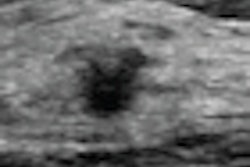
If women being treated with tamoxifen for breast cancer see their breast density drop, they may have a 50% lower risk of dying from the disease, according to a new study by Swedish researchers published online April 22 in the Journal of Clinical Oncology.
In a study that hints at a role for breast density measurement in predicting therapy response, researchers at Karolinska Institutet in Stockholm found that women who had a relative reduction of more than 20% in the absolute dense area of their breast tissue during the course of tamoxifen treatment had a 50% reduction in breast cancer mortality over a span of 15 years, compared with women who had little or no change (JCO, April 22, 2013).
Tamoxifen is usually given over five years to prevent the recurrence of breast cancer in women who have completed their primary treatment. The researchers conducted the study to assess whether there was a link between reduced tissue density and the effectiveness of tamoxifen therapy.
 Dr. Per Hall from Karolinska Institutet.
Dr. Per Hall from Karolinska Institutet.
No method has been available for assessing which women are likely to respond to tamoxifen and not relapse with breast cancer, according to Dr. Per Hall and colleagues.
"To the best of our knowledge, this is the first time mammographic density change has been used as a prognostic marker of response to tamoxifen," Hall and colleagues wrote. "We observed that women treated with tamoxifen who experienced mammographic density reduction were associated with substantially better long-term breast-cancer-specific survival. If validated, mammographic density change has the potential to be an early marker for therapy response."
For the study, Hall and colleagues included data collected in Sweden between 1993 and 1995 from 974 postmenopausal patients with breast cancer who had both baseline and follow-up mammograms. Of these, 474 patients received tamoxifen treatment and 500 did not. The team measured mammographic density using a statistical method that expressed the data as absolute dense area.
During the follow-up period, 121 patients (12.4%) died from breast cancer. But women who were treated with tamoxifen and who experienced a relative density reduction of more than 20% had a 50% lower risk of death, compared with women whose breast density didn't change, the team found.
In the group that was not treated with tamoxifen, there was no statistically significant association between mammographic density change and survival, and the survival advantage was not found when absolute dense areas at baseline or follow-up were evaluated separately.
The findings come on the heels of a recommendation issued on April 15 from the U.S. Preventive Services Task Force (USPSTF) regarding the use of tamoxifen and a related drug, raloxifene, as preventive measures against breast cancer in asymptomatic women. The USPSTF suggests that women who are at increased risk for breast cancer talk to their physician about the potential benefits and harms of the drugs to prevent breast cancer; women who are not at increased risk should not use them.
If further research confirms the Swedish group's findings, mammographic density change has the potential to be an early marker for therapy response, Hall and colleagues wrote. In fact, given ongoing developments in automatic algorithms for mammographic density measurement, using density change to monitor the effectiveness of treatment could be a cost-effective clinical tool.
"What's needed is accurate measurement of mammographic density," Hall said in a statement released by the Karolinska Institutet. "Measuring changes in density can be a simple and cheap means of assessing the effect of the treatment. If a patient is not responding to tamoxifen, maybe they should be given a different drug."




















